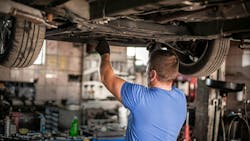Three ways to improve lift safety
Quality technicians are the lifeblood of any professional shop. In my experience, shops do a great job of educating technicians in several aspects of their everyday work. However, one area where qualified training is lacking is how to properly lift and secure a vehicle.
Every time a vehicle is lifted off the ground, shop management trusts that the technician has followed all proper procedures for safety and security. If the technician is not appropriately trained and does not follow the correct proce dures, the results can be catastrophic. To ensure a safe lifting environment, a shop must buy the correct lift for the job, maintain said lift through certified inspections, and have a formal lift train ing program.
Making a safe purchase
In purchasing a lift, the most impor tant consideration is safety. To start, shops should make sure the lift is of the proper capacity and can access the manufacturer’s recommended lifting points for the types of vehicles they are servicing. Different types of lifts reach these lifting points through dif ferent methods; they may be drive-on, two-post, or wheel-engaging mobile columns. With the variety of lift options available, shops may want to consult a trusted professional to help determine the best lift for their shop’s specific needs.
Additionally, shops should confirm the lift is Automotive Lift Institute (ALI)-certified before purchase. ALI certified lifts have been third-party tested to meet all safety standards.
Maintenance and inspection
Proper maintenance and inspection of any lift is a key to continued safe lifting. All lifts should be maintained strictly adhering to the respective manufacturer’s guidelines and inspected annually to ensure a safe shop. The American National Safety Standard requires a lift owner to utilize a qualified lift inspector to inspect all lifts a minimum of once a year. A proper lift inspection will include an examination of all lift components along with making sure all decals and safety materials are present. Detailed records should be kept on inspection findings to ensure existing issues are addressed in a timely fashion and can be prevented in the future. The Automotive Lift Institute has developed a certified lift inspection program to provide users with certification of the lift inspection.
Training
The last component of safe lifting is technician training. Most technicians probably know the basics of lifting and securing vehicles, but it is easy to fall into bad habits. Formalizing a lift training program in a shop can help provide peace of mind in knowing the technicians are following proper lifting procedures. Each shop should tailor a program around their specific shop needs.
To help shops create their lifting programs, ALI offers the Lifting it Right program. This program explains the correct way to lift vehicles safely and provides a certification of completion to help with training records in compliance with national safety training requirements.
Overall, anytime a technician walks under a vehicle on a lift, they trust the vehicle has been correctly lifted and secured. If not, the results could be disastrous. So make sure your lifts have been properly certified and maintained, and all technicians have been formally trained on their proper use.
